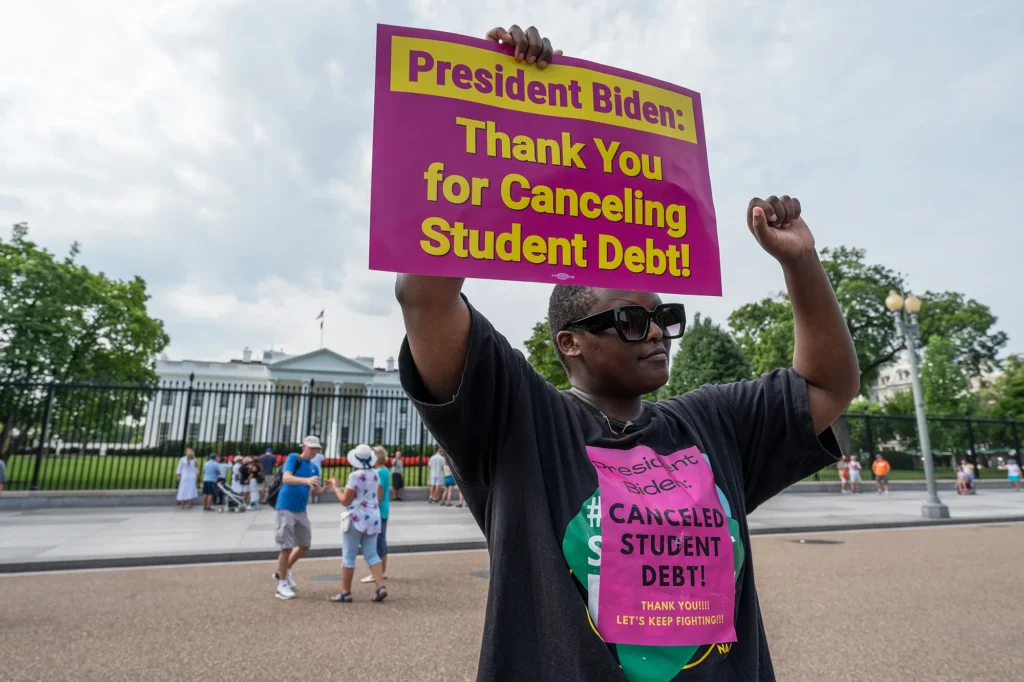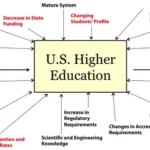In August 2022, President Biden announced his plan to forgive up to $20,000 in federal student loan debt for Pell Grant recipients, and up to $10,000 for other federal student loan borrowers, fulfilling a campaign promise. This sweeping action aims to relieve the burden of student debt for millions of Americans. Biden Student Loan Forgiveness details here!
Under Biden’s plan, individual borrowers who earned less than $125,000 in either 2020 or 2021 and married couples or heads of households who made less than $250,000 annually in those years will be eligible for up to $10,000 in forgiveness. For recipients of Pell Grants, which are reserved for undergraduates with the most significant financial need, the debt forgiveness will be doubled to up to $20,000.
Biden also extended the pandemic-era pause on federal student loan payments through December 31, 2022. The pause will help provide financial certainty to tens of millions of student loan borrowers as debt cancellation is implemented.
The announcement marked a major milestone in Biden’s domestic agenda. The White House estimates the debt cancellation will eliminate the full remaining balance on loans for about 20 million borrowers. Overall, up to 43 million Americans are expected to benefit. The plan aims to tackle growing concerns about education costs and massive student debt burdens that are seen as weighing down a generation.
Background
Student loan debt has become a major crisis in the United States over the last few decades. Total student loan debt now stands at over $1.7 trillion, spread out among 45 million borrowers. This is nearly triple what it was just 15 years ago.
The causes of this massive growth in student debt are multifaceted. For one, college tuition costs have risen dramatically faster than inflation. Over the past 20 years, average tuition at public 4-year colleges has more than doubled, even after accounting for inflation. At the same time, state funding for public colleges has declined, pushing more of the costs onto students and families.
On top of rising costs, more Americans are pursuing higher education than in the past. College enrollment grew by 43% between 2000-2010. With more students taking out loans for college, total student debt has skyrocketed.
This combination of higher costs and more enrollment has left many students buried under large amounts of debt. Today the average graduate with student loans leaves college with over $30,000 in debt. For graduate students, that figure is even higher, with an average debt load of $71,000.
With such high debt burdens, many borrowers struggle to pay back their loans. Delinquency and default rates have increased substantially in the last decade. Currently over 10% of borrowers are in default on their student loans.
The weight of student debt has wider economic impacts as well. It holds back home ownership rates for young people, prevents saving for retirement, and limits small business formation and entrepreneurship. Student debt has become not just an individual burden, but a drag on the entire U.S. economy.
Find More Valuable Content On: Revolve Loan
Details of Biden’s Plan
President Biden’s student loan forgiveness plan focuses on providing relief for federal student loan borrowers who earn less than $125,000 a year (or $250,000 for married couples). The key details include:
-
Who Qualifies: The debt relief applies to borrowers with federal student loans who earn under the income thresholds. This includes current students with federal loans, as well as those who have already graduated. The income limits apply based on either your 2020 or 2021 tax return.
-
Income Thresholds: Borrowers who earn under $125,000 a year (or $250,000 for married couples) will be eligible for up to $10,000 in debt relief. There is a phase-out for those earning between $125,000-$150,000 (or $250,000-$300,000 for couples), who will receive progressively less debt relief. Those earning over the phase-out limits will not receive any debt relief.
-
Amount of Debt Relief: Eligible borrowers will receive up to $10,000 in debt cancellation. For borrowers who received Pell Grants while in college, the amount increases to up to $20,000 in debt relief. The relief applies to the original principal loan amount, so the debt cancellation will reduce loan balances by the specified amount.
Reactions
President Biden’s student loan forgiveness plan has received a wide range of reactions from various groups and individuals.
Supporters
Many Democrats and progressive groups have expressed strong support for Biden’s plan. They argue that student debt is crushing an entire generation and this plan will provide much-needed relief. Supporters say the economy will benefit if people have more disposable income without student loan payments. Education and civil rights groups also back the plan, saying it will help close racial wealth gaps since Black students on average carry more student debt than white students.
Critics
However, Biden’s plan also faces criticism from several directions. Many Republicans have blasted the plan as an unfair government handout and overreach. They say it will increase inflation and benefit high-earning graduate degree holders. Some economists warn about the high cost to taxpayers. The Committee for a Responsible Federal Budget estimates the total cost could exceed $500 billion. Some advocates say the plan doesn’t go far enough and are calling for broader student debt cancellation. Groups representing private lenders and loan servicers have also voiced opposition, saying it will hurt future lending.
Potential Impact
President Biden’s student loan forgiveness plan has the potential to provide relief to millions of borrowers, while also impacting the broader economy.
Impact on Borrowers
-
The $10,000 in debt cancellation per federal loan borrower would eliminate the balances for roughly one-third of borrowers. This relief could allow borrowers to redirect funds previously used for loan payments to other expenses and investments.
-
Borrowers who took out loans for graduate school and received PLUS loans stand to benefit even more, with up to $20,000 in debt forgiveness. This group often faces higher debt burdens.
-
Relief for borrowers could help them buy homes, start businesses, and begin families sooner due to reduced debt obligations.
-
Critics argue the plan does not go far enough and $10,000-$20,000 does not address systemic issues that caused high debt. Some say broad forgiveness is unfair to those who already paid off loans.
Economic Impact
-
Proponents argue forgiveness will provide consumer spending stimulus, as borrowers redirect loan payments to goods and services.
-
Critics counter that benefits may be limited, as higher income graduates are the largest borrowers. They argue debt relief often does not translate to spending.
-
The impact on inflation is debated. If consumer spending rises, it could further increase inflation. Others argue any effect would be modest.
-
The overall economic impact will depend on how many borrowers receive debt relief and how they adjust personal finances in response.
Criticisms
The student loan forgiveness plan has faced criticism from several fronts. Some argue that mass debt cancellation is unfair to those who worked hard to pay off their loans or chose not to take on debt in the first place. Broad forgiveness could also incentivize irresponsible borrowing behavior in the future if students expect their loans will also be canceled down the line.
Additionally, student loan cancellation does not address the root causes of rising college costs and could actually enable colleges to raise prices even higher. Forgiveness may also disproportionately benefit high-earning graduate degree holders rather than those most in need.
From an economic standpoint, mass debt forgiveness could fuel inflation and increase the national deficit. Some analysts predict loan cancellation could cost the government over $500 billion. Opponents argue there are better targeted ways to provide relief to those struggling most with student debt.
Legal scholars have raised questions about whether the executive branch has authority for widescale debt cancellation without Congress. Mass loan forgiveness could face challenges in the courts.
Overall, critics say broad student debt forgiveness is a regressive policy that forces taxpayers to cover costs incurred by college graduates who willingly took out loans. They argue targeting relief based on income, degree type or institution would be a more prudent approach.
Alternatives
While President Biden’s broad student loan forgiveness plan has gained a lot of attention, there are other policy options that could be considered.
One alternative is more targeted loan forgiveness. This could involve forgiving loans for certain categories of borrowers, such as those in lower income brackets or those working in public service. The goal would be providing relief for those who need it most.
Income-driven repayment plans are another option. These set student loan payments as a percentage of discretionary income and provide forgiveness after 20-25 years of payments. Enhancing these programs could make payments more affordable without sweeping across-the-board forgiveness.
Refinancing and lowering interest rates on federal student loans could also provide financial relief for borrowers. This may be more politically feasible than mass loan cancellation.
Some argue that addressing the root causes of rising tuition could be more impactful in the long run. Ideas include increasing public funding for higher education, creating incentives for colleges to limit costs, and revising student loan programs.
Free or debt-free college is another progressive proposal for tackling student debt at the source. This would eliminate tuition for public colleges and universities to reduce the need for loans.
There are many alternatives to evaluate beyond blanket student loan forgiveness. A balanced policy approach could incorporate several targeted reforms to aid borrowers in need.
Legal Challenges
President Biden’s student loan forgiveness plan has faced multiple lawsuits challenging its legality since being announced in August 2022. Opponents argue the plan overreaches the president’s authority and violates federal law.
Several conservative-leaning states filed lawsuits arguing Biden cannot enact such sweeping debt cancellation without Congress. A federal judge in Missouri temporarily blocked the plan in response to one of the lawsuits, ruling that the plaintiffs raised “important and substantial” legal questions about the plan. The Biden administration quickly appealed to a higher court and won a stay of that ruling.
Other lawsuits came from conservative legal groups on behalf of individual borrowers who did not qualify for relief under the plan. Their argument is that Biden’s targeting of relief based on income levels is unfair.
At issue is whether Biden has authority under the 2003 HEROES Act to cancel student loan debt during a national emergency like the COVID-19 pandemic. The White House asserts this law allows such action to address economic harms, but challengers dispute this interpretation.
The ultimate legality of Biden’s student debt forgiveness plan rests in the hands of the courts. Most experts expect it will eventually reach the Supreme Court. Until these cases are resolved, the plan faces uncertainty and legal limbo. Its opponents hope the judiciary will strike down or limit the debt cancellation. Supporters argue the plan falls within the president’s powers. The final outcome remains to be seen.
What’s Next
President Biden’s student loan forgiveness plan marks a major step in addressing the $1.7 trillion student debt crisis, but many believe additional action is still needed. Here are some potential future steps that could build on this initial debt relief:
-
Further loan forgiveness programs – Biden’s plan grants up to $10,000 in forgiveness for federal student loan borrowers making under $125,000 per year. Many advocates argue this doesn’t go far enough and are calling for repeat loan forgiveness programs or forgiveness of larger amounts. Biden has expressed openness to forgiveness beyond his current plan.
-
Long-term reforms to college costs – Loan forgiveness provides relief now, but major reform is needed to address the root of the student debt crisis – the soaring cost of college tuition. Ideas like tuition-free public college, increased Pell Grants, and accountability for universities have been proposed.
-
Changes to income-based repayment plans – Reform is needed to existing income-driven repayment plans to make them more generous and accessible. Plans could have lower monthly payments, longer forgiveness timelines, and reduced eligibility requirements.
-
Discharge of private student loans – Federal loans are addressed in Biden’s plan, but millions also hold private student debt. Discharging these loans is challenging, but proposals exist to make private debt eligible for future forgiveness programs.
-
Permanent changes to bankruptcy laws – Current bankruptcy laws make discharging student loans extremely difficult. Changing bankruptcy codes to allow student debt to be more easily discharged could provide an ongoing path to relief.
While Biden’s plan delivers help to millions, the student debt crisis took decades to develop and will require further bold ideas and bipartisan efforts to fully address in the long run. With student debt reform now at the forefront, the door is open for continued progress.
Conclusion
In summary, President Biden’s student loan forgiveness plan aims to provide relief to millions of Americans struggling under the burden of student debt. However, it has also faced criticism and legal challenges from opponents.
The plan will forgive up to $10,000 in federal student loans for those making under $125,000 a year, and up to $20,000 for Pell grant recipients. This will eliminate student debt entirely for around 20 million borrowers. Supporters praise the plan as a bold measure that will stimulate the economy and assist lower income households.
However, opponents argue the plan is unfair to those who have already paid off loans or chose not to attend college. Some economists warn it may contribute to inflation and provide an incentive for colleges to raise tuition further. Multiple lawsuits have been filed challenging Biden’s authority to enact broad debt cancellation.
The future of the plan remains uncertain as it works its way through the courts. Regardless, America’s student debt crisis continues to grow. Broader reforms to college costs and lending may ultimately be needed to provide a long-term solution. For now, Biden’s forgiveness plan remains divisive, with strong advocates on both sides of the issue. Its full impacts may not be clear for years to come.



